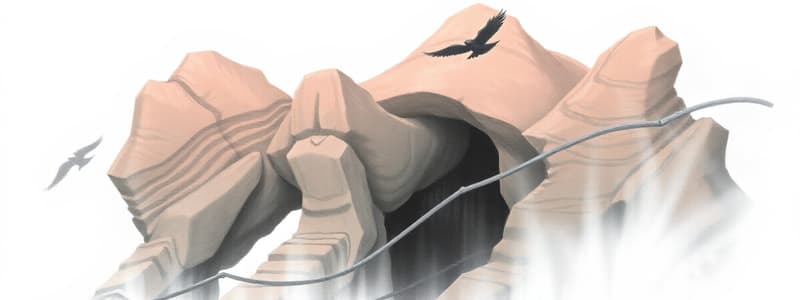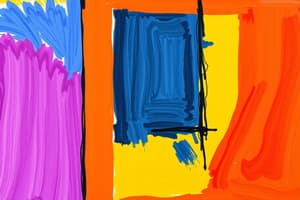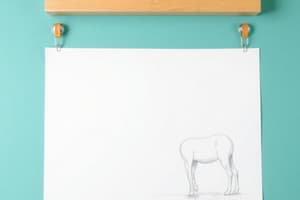Podcast
Questions and Answers
Which of the following is a visual art form where artists mark a two-dimensional medium?
Which of the following is a visual art form where artists mark a two-dimensional medium?
- Sculpting
- Pottery
- Photography
- Drawing (correct)
What is the term for an artist who practices drawing?
What is the term for an artist who practices drawing?
- Drafter (correct)
- Sculptor
- Painter
- Photographer
Cave paintings are an example of what?
Cave paintings are an example of what?
- Renaissance Sculpture
- Modern Art
- Digital Illustration
- Prehistoric Drawing (correct)
Which material became widely available in the 16th century, expanding drawing possibilities?
Which material became widely available in the 16th century, expanding drawing possibilities?
Using closely spaced parallel lines to create shading is known as what?
Using closely spaced parallel lines to create shading is known as what?
What is the dry drawing medium made from charred wood?
What is the dry drawing medium made from charred wood?
Which type of drawing focuses on capturing the movement and essence of a subject?
Which type of drawing focuses on capturing the movement and essence of a subject?
Creating the illusion of depth on a 2D surface is achieved through what drawing technique?
Creating the illusion of depth on a 2D surface is achieved through what drawing technique?
Which field uses drawing to create detailed plans for buildings?
Which field uses drawing to create detailed plans for buildings?
Which artist is known for anatomical studies and preparatory drawings?
Which artist is known for anatomical studies and preparatory drawings?
Flashcards
Drawing
Drawing
A visual art form using instruments to mark paper or other 2D medium.
Hatching
Hatching
Using closely spaced parallel lines for shading and tonal effects.
Cross-hatching
Cross-hatching
Intersecting sets of parallel lines creating darker tones and shading.
Stippling
Stippling
Signup and view all the flashcards
Blending
Blending
Signup and view all the flashcards
Contour drawing
Contour drawing
Signup and view all the flashcards
Gesture drawing
Gesture drawing
Signup and view all the flashcards
Perspective drawing
Perspective drawing
Signup and view all the flashcards
Chiaroscuro
Chiaroscuro
Signup and view all the flashcards
Life drawing
Life drawing
Signup and view all the flashcards
Study Notes
- Drawing is a visual art form where artists use instruments to mark paper or other two-dimensional media.
- Drawing instruments: graphite pencils, pen and ink, paints, inked brushes, colored pencils, crayons, charcoal, chalk, pastels, erasers, styluses, and metals.
- Artists who draw are called drafters, draftsmen, or draughtsmen.
- Drawing creates representational, abstract, or symbolic art.
- It's a key skill in visual arts, used in architecture, engineering, and animation.
History of Drawing
- Drawing is an ancient visual expression, with prehistoric examples.
- Cave paintings in Lascaux, France, show early humans drawing animals and scenes.
- Ancient Egypt and Greece used drawing for architectural plans, religious illustrations, and portraits.
- The Renaissance emphasized drawing in artistic training; Leonardo da Vinci used it for studies and sketches.
- 16th-century graphite pencils expanded drawing possibilities.
Drawing Techniques
- Hatching: Close, parallel lines create shading and tone.
- Cross-hatching: Intersecting parallel lines create darker tones and complex shading.
- Stippling: Dots create shading and texture; denser dots create darker tones.
- Blending: Smoothing tones and transitions by rubbing or smudging.
- Contour drawing: Outlines and shapes are emphasized without shading.
- Gesture drawing: Captures movement and essence quickly.
- Perspective drawing: Creates depth on a 2D surface using vanishing points and horizon lines.
- Chiaroscuro: Strong light and dark contrasts create drama.
Drawing Materials
- Graphite pencils: Varying hardness (H to B) creates tones and textures.
- Charcoal: Charred wood creates dark tones and drama.
- Pen and ink: Creates precise lines and details, often with hatching and cross-hatching.
- Colored pencils: Colored cores create various colors and effects.
- Pastels: Pigment sticks with a binder create soft, painterly effects.
- Erasers: Correct mistakes and create highlights; different types suit different media.
- Drawing papers: Varying weights, textures, and colors suit different techniques.
Types of Drawing
- Life drawing: Drawing from live models to study anatomy.
- Still life drawing: Drawing arranged objects to study form and light.
- Landscape drawing: Captures natural scenery.
- Portrait drawing: Captures a person's likeness and personality.
- Technical drawing: Used in engineering and architecture for plans.
- Illustrative drawing: Creates images for publications.
- Cartooning: Creates humorous images with exaggeration.
- Abstract drawing: Explores shapes and colors non-representationally.
Drawing in Different Fields
- Architecture: Used for sketches, plans, and presentations of buildings.
- Engineering: Used for technical drawings to communicate specifications.
- Animation: Used for storyboards, character designs, and keyframes.
- Fashion design: Used to sketch garment designs and illustrations.
- Medical illustration: Creates detailed anatomy and procedure illustrations.
- Forensic art: Creates facial reconstructions for investigations.
Notable Drafters
- Leonardo da Vinci: Known for anatomical studies, sketches, and preparatory drawings.
- Michelangelo: Known for powerful figure drawings and architectural plans.
- Rembrandt van Rijn: Known for expressive use of light and shadow.
- Edgar Degas: Known for drawings of dancers and Parisian life.
- Käthe Kollwitz: Known for emotionally charged drawings and prints.
- David Hockney: Known for diverse work including drawings, paintings, and photography.
Tips for Improving Drawing Skills
- Practice regularly to improve coordination.
- Start with basic shapes and build complexity.
- Pay attention to proportions and perspective.
- Experiment with materials and techniques.
- Study master drafters.
- Seek feedback for improvement.
- Be patient and persistent.
Studying That Suits You
Use AI to generate personalized quizzes and flashcards to suit your learning preferences.




